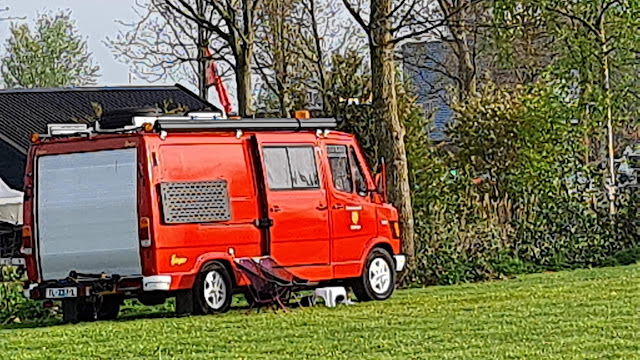Week 15 Re-charging the Batteries
Week 15
We've been doing the house renovations for 5.5 months now - along with a few other projects and the normal business routine...so we had a weekend off - on the boat!
Early Beginnings (Medieval Era):
Strategic Location: Joure's story likely begins around the 8th or 9th century AD. Its location at the crossroads of the river Joustervaart and the Tjonger waterway proved to be strategically important.exclamation Settlements likely arose around this time, taking advantage of the convenient transportation routes.
Earthen Mounds: Evidence suggests early settlements in Joure may have involved building "terpen," which are artificial mounds of earth used as elevated living areas for protection from flooding, a common concern in the region.
Rise of a Trading Hub (13th-15th Centuries):
Charter and Market Rights: Joure received its official town charter in 1455, granted by the Duke of Burgundy.exclamation This charter bestowed upon Joure market rights, solidifying its position as a trading center.
Flourishing Trade: The town flourished as a center for trade in agricultural products like dairy, cattle, and peat.exclamation The waterways surrounding Joure facilitated the transportation of goods, connecting it to other towns and regions.
Church Construction: The construction of the imposing St. Nicolaaskerk (St.exclamation Nicholas Church) in the 15th century stands as a testament to Joure's growing prosperity during this period.
Challenges and Resilience (16th-18th Centuries):
Religious Conflicts: The Protestant Reformation of the 16th century brought religious tensions to Joure, as in many parts of Europe. Despite these challenges, the town persevered.
Fires and Floods: Joure faced its share of adversity, including several devastating fires and floods. However, the townspeople displayed remarkable resilience, rebuilding and recovering each time.
Modern Joure (19th Century-Present):
Industrial Growth: The 19th century saw the arrival of industry to Joure, with businesses like shipyards and brickworks contributing to the town's economic development.
Tourism and Recreation: In the 20th and 21st centuries, Joure increasingly embraced tourism, leveraging its charming canals, historic buildings, and natural surroundings to attract visitors. Today, Joure offers a vibrant cultural scene, with museums, festivals, and events celebrating its rich heritage.
Interesting Facts:
Joure is known for its traditional Frisian houses, characterized by their colorful facades and distinctive architectural features.
The town center boasts well-preserved canals, adding to its picturesque charm.expand_more
Joure is a center for the production of "Beerenburg," a unique Frisian herbal liqueur.
Next door to the haven is a Yacht Club. A crane was busy lifting ALL the boats into the water - we reckoned that the club must hire the crane for the day and everyone goes in...
Start of the day
A mammoth journey of 21 kms - or about 7 kms as the crow flies...as Janny said "we could have walked there faster".
But we had a much-needed relaxing weekend - walking, eating, enjoying not having anything to do. We ate out twice!!
New shelves
I'm still mucking around with AI - ChatGTP and Gemini
(from Google's Gemini - I asked it for a brief history of Joure)
Joure, nestled in the heart of Friesland, boasts a rich history dating back centuries. Here's a glimpse into the town's fascinating past:
Early Beginnings (Medieval Era):
Strategic Location: Joure's story likely begins around the 8th or 9th century AD. Its location at the crossroads of the river Joustervaart and the Tjonger waterway proved to be strategically important.exclamation Settlements likely arose around this time, taking advantage of the convenient transportation routes.
Earthen Mounds: Evidence suggests early settlements in Joure may have involved building "terpen," which are artificial mounds of earth used as elevated living areas for protection from flooding, a common concern in the region.
Rise of a Trading Hub (13th-15th Centuries):
Charter and Market Rights: Joure received its official town charter in 1455, granted by the Duke of Burgundy.exclamation This charter bestowed upon Joure market rights, solidifying its position as a trading center.
Flourishing Trade: The town flourished as a center for trade in agricultural products like dairy, cattle, and peat.exclamation The waterways surrounding Joure facilitated the transportation of goods, connecting it to other towns and regions.
Church Construction: The construction of the imposing St. Nicolaaskerk (St.exclamation Nicholas Church) in the 15th century stands as a testament to Joure's growing prosperity during this period.
Challenges and Resilience (16th-18th Centuries):
Religious Conflicts: The Protestant Reformation of the 16th century brought religious tensions to Joure, as in many parts of Europe. Despite these challenges, the town persevered.
Fires and Floods: Joure faced its share of adversity, including several devastating fires and floods. However, the townspeople displayed remarkable resilience, rebuilding and recovering each time.
Modern Joure (19th Century-Present):
Industrial Growth: The 19th century saw the arrival of industry to Joure, with businesses like shipyards and brickworks contributing to the town's economic development.
Tourism and Recreation: In the 20th and 21st centuries, Joure increasingly embraced tourism, leveraging its charming canals, historic buildings, and natural surroundings to attract visitors. Today, Joure offers a vibrant cultural scene, with museums, festivals, and events celebrating its rich heritage.
Interesting Facts:
Joure is known for its traditional Frisian houses, characterized by their colorful facades and distinctive architectural features.
The town center boasts well-preserved canals, adding to its picturesque charm.expand_more
Joure is a center for the production of "Beerenburg," a unique Frisian herbal liqueur.
I also asked ChatGTP and it included this line...which is simply NOT TRUE - so it all has to be taken with a grain of salt, I guess.
Today, Joure retains much of its historic charm while embracing modernity and innovation. Its picturesque waterfront, lined with cafes, shops, and restaurants
We had hoped that Ankie and Henk would come down with their new camper - but they couldn't make it. We checked out the camper arrangements - most of the boat harbours seem to offer spots for campers these days...
This one caught my eye, of course
Start of the day

















Comments
Post a Comment